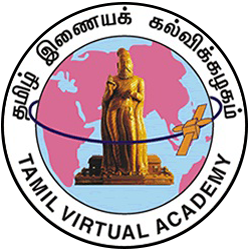Primary tabs
- A05141 : Lesson - 1THE GROWTH OFTHE TAMIL SCRIPT
Language can be said to have two forms--spoken and written. Changes have taken place in both these forms through the ages. This lesson gives you a detailed account of the changes that have taken place in the script and dialects of Tamil and the reforms that have been introduced.
Language is a form of communication. The use of language for communication has been in existence for thousands of years. There are thousands of languages in the world. Of these, some are used for speaking and writing; some are used only for speaking, for they do not have a script; and some are used only for writing literary, grammatical and religious works (for example, Sanskrit). We can take pride in saying that Tamil belongs to the first category. It has been spoken and written for the past thousands of years.
Living languages are subject to constant change. When the spoken language changes, dialects are born. When the written language changes, new scripts are born. We can classify dialects into four types:
(1) Regional dialect
(2) Social dialect
(3) Caste dialect
(4) Temporal dialect
Written language lives longer than spoken language. Men have used three different scripts to express themselves -- Pictography, syllabic Writing, and Phonetic writing. Japanese and Chinese use Pictography for their letters. All the Indian languages including Tamil use syllabic writing, while French and German use phonetic writing.
We mentioned that only some languages have scripts. Among such languages, some are unique in that they have a script that is not shared by any other language; for example, Tamil. Languages like Hindi, Marathi and Sanskrit share the same script which is called Devanaagari. Similarly, English, French, German and Dutch share the Roman script.
Veeramaamunivar brought about certain changes in the forms of letters. In modern times, Periyar E.V.Ramasamy brought about reforms in the formation of Tamil letters like ‘naa’, ‘no’, ‘lai’, ‘nai’ etc.
There are some who belive that the Tamil script needs to be reformed. Others feel that there is no such need. But when we study the history of the Tamil language, we find that change is inevitable and will occur whenever necessary, whether we like it or not.முன்


